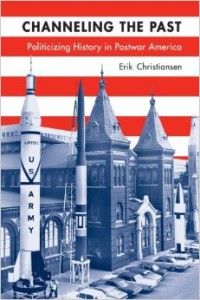Erik Christiansen. Channeling the Past: Politicizing History in Postwar America. (Madison, Wisconsin: University of Wisconsin Press, 2013) 302 pages.
Review by Nick Witham
In a 1955 episode of the CBS historical education series You Are There entitled “The Emancipation Proclamation,” viewers are presented with an on-the-ground news report relating the responses of various Civil War-era Americans to Abraham Lincoln’s famous executive order. In presenting this televised historical re-enactment (if we can call it that, given the interpolation of TV journalists into the fray), You Are There broke with the mainstream of 1940s and 1950s US historiography by presenting the events of 1 January 1863 through the eyes of recently freed slaves. As Erik Christiansen relates in his excellent 2013 book Channeling the Past, in one amazing and powerful scene, viewers watch “as the slaves transform themselves into full citizens,” thus rendering the words and actions of their President “almost irrelevant.” This was a dramatically different version of Civil War history than that presented in school and university textbooks of the period, and, in Christiansen’s view, was the result of a politically motived script penned by a screenwriter with a distinctively leftist perspective on the US past: blacklistee Howard Rodman (135).
Under the auspices of CBS’s popular history imprimatur, then, the US past was politicized in an unexpected and progressive way. However, the presence of this type of historical narrative within the mainstream of US culture should not have historians rushing to rethink the “consensus” label commonly applied to attitudes towards the past held by Americans at mid-century. Indeed, as Christiansen perceptively shows, whilst You Are There’s representation of the Emancipation Proclamation reflected a surprisingly unorthodox historiographical perspective, much more representative of the era’s attempts to engage the general public’s interest in history was the mural that appeared next to the Proclamation on the “Freedom Train” that toured the nation between 1947 and 1949, carrying 126 historical documents to 322 towns in all 48 states: it contained no reference to African Americans whatsoever (170).
The central purpose of Channeling the Past is to document the ways in which a political climate of early Cold War uncertainty about America’s place in the world, technological and cultural developments in radio, television and advertising, and a willingness to engage with the general public amongst US historians, all combined to create a period that was “inundated by a wide variety of projects focused on connecting contemporaries with particular perspectives on the past. (4)” To demonstrate this point, the author turns to a series of fascinating case studies, with You Are There and the Freedom Train joined as the subjects of individual chapters by the History Book Club, Du Pont’s radio and television series Cavalcade of America, and the Smithsonian’s National  Museum of American History.
Museum of American History.
In each of these chapters, Christiansen highlights the tensions that developed between the desire for narratives of US history that were directed by an elite of historians with demonstrable critical expertise, and the demand for commercial success and a sympathetic treatment not only of the state, but also of big business. For example, in fashioning the History Book Club (HBC) in the late 1940s, the journalist Bernard De Voto and the historian Arthur Schlesinger, Jr. were driven by a desire to allow “a select group of historians…to show thousands of other Americans how the past, as they knew it, informed the present.” At the same time, they demonstrated their liberal political proclivities by choosing texts to be distributed by the network that were critical of “growing corporate power and the resurgence of conservatism. (22-24)” However, this dream was short-lived, as the HBC was repeatedly stymied by the conflict between pedagogy and profit, a situation that resulted in the organization’s eventual decision to ignore texts that were critical of the US past in favour of those that pandered to nationalistic sentiments that would be easily consumed by the general public (52).
The producers of Du Pont’s Cavalcade of America (1935-1953), on the other hand, had no qualms about commercializing US history. The chemical company made sure the radio and television shows it sponsored were styled as educational, rather than explicitly propagandistic. However, this did not stop it attempting to “reshape the past into a consistent argument against government regulation,” in a bid to turn the American public against the policies of the New Deal (53). Individual shows such as “The Spirit of Competition” (1935), for example, argued that the corporation’s history was synonymous with the nation’s history: “Just as the traditions of American character grew up with our nation – so did the Du Pont company grow up with the nation to occupy an increasingly useful place in our economic life. (66)” Later in its life-cycle, Cavalcade used sophisticated techniques developed by advertising agency BBDO to measure audience responses to individual shows, and therefore present them with exactly the type of history they wanted. Once again, then, the lines between history, politics and commercialism were blurred in significant and telling ways.
In discussing the development of the Museum of American History (MAH), Christiansen builds on a considerable body of literature on the topic, much of it written under the influence of “culture wars” debates about the functions of the museum in the aftermath of the Enola Gay controversy in 1994-5. The author details the manner in which the MAH become “the site of an intensely patriotic, pro-military, and pro-business history created through the cooperation of corporations and the state. (187)” This version of US history was shaped during a period in which museums were beginning to be conceived as not as “national repositories” but as “public-learning complexes. (189)” Public history was therefore conceived of as utilitarian: rather like subscribers to the HBC, museum-goers would be encouraged to reflect on the way that the “experience of the past” could be applied to the “problems of the present. (221)” However, the terms of reference for this apparently democratic popular history were strictly circumscribed: questions of labor relations or racial inequality, for example, were nowhere to be seen.
Overall, these various case studies allow Christiansen to craft a careful and illuminating narrative about public attitudes towards US history in the 1940s and 1950s. Channeling the Past draws on a range of interesting archival material, and shows in a series of concrete and nuanced ways how popular memories were both culturally constructed and highly politicized during a period in which Americans were coming to terms with their nation’s place in the postwar world. In doing so, the book demonstrates how seriously historians should take the idea of engaging with “popular” audiences, at the same time as it highlights the contradictions inherent in projecting our voices beyond the academy.
Nick Witham is Senior Lecturer in American Social and Cultural History at Canterbury Christ Church University, UK, and Associate Editor of the Journal of American Studies (Cambridge University Press). His book The Cultural Left and the Reagan Era: U.S. Protest and Central American Revolution is out now. He is currently working on a project  that examines “popular” history writing in the postwar US, as exemplified by Richard Hofstadter, John Hope Franklin, Daniel Boorstin and Howard Zinn.
that examines “popular” history writing in the postwar US, as exemplified by Richard Hofstadter, John Hope Franklin, Daniel Boorstin and Howard Zinn.

0